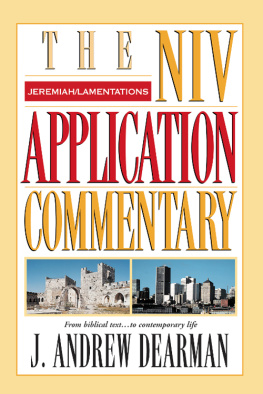Jeremiah McCall - Swords and Cinema
Here you can read online Jeremiah McCall - Swords and Cinema full text of the book (entire story) in english for free. Download pdf and epub, get meaning, cover and reviews about this ebook. year: 2015, publisher: Pen & Sword Books, genre: History. Description of the work, (preface) as well as reviews are available. Best literature library LitArk.com created for fans of good reading and offers a wide selection of genres:
Romance novel
Science fiction
Adventure
Detective
Science
History
Home and family
Prose
Art
Politics
Computer
Non-fiction
Religion
Business
Children
Humor
Choose a favorite category and find really read worthwhile books. Enjoy immersion in the world of imagination, feel the emotions of the characters or learn something new for yourself, make an fascinating discovery.
- Book:Swords and Cinema
- Author:
- Publisher:Pen & Sword Books
- Genre:
- Year:2015
- Rating:4 / 5
- Favourites:Add to favourites
- Your mark:
- 80
- 1
- 2
- 3
- 4
- 5
Swords and Cinema: summary, description and annotation
We offer to read an annotation, description, summary or preface (depends on what the author of the book "Swords and Cinema" wrote himself). If you haven't found the necessary information about the book — write in the comments, we will try to find it.
Swords and Cinema — read online for free the complete book (whole text) full work
Below is the text of the book, divided by pages. System saving the place of the last page read, allows you to conveniently read the book "Swords and Cinema" online for free, without having to search again every time where you left off. Put a bookmark, and you can go to the page where you finished reading at any time.
Font size:
Interval:
Bookmark:
For Olivia
First published in Great Britain in 2014 by
Pen & Sword Military
an imprint of
Pen & Sword Books Ltd
47 Church Street
Barnsley
South Yorkshire
S70 2AS
Copyright Jeremiah McCall 2014
ISBN: 978 1 84884 476 6
PDF ISBN: 978 1 47387 597 5
EPUB ISBN: 978 1 47387 596 8
PRC ISBN: 978 1 47387 595 1
The right of Jeremiah McCall to be identified as the Author of this Work has been asserted by him in accordance with the Copyright, Designs and Patents Act 1988.
A CIP catalogue record for this book is available from the British Library
All rights reserved. No part of this book may be reproduced or transmitted in any form or by any means, electronic or mechanical including photocopying, recording or by any information storage and retrieval system, without permission from the Publisher in writing.
Typeset in Ehrhardt by
Mac Style Ltd, Bridlington, East Yorkshire
Printed and bound in the UK by CPI Group (UK) Ltd,
Croydon, CRO 4YY
Pen & Sword Books Ltd incorporates the imprints of Pen & Sword Archaeology, Atlas, Aviation, Battleground, Discovery, Family History, History, Maritime, Military, Naval, Politics, Railways, Select, Transport, True Crime, and Fiction, Frontline Books, Leo Cooper, Praetorian Press, Seaforth Publishing and Wharncliffe.
For a complete list of Pen & Sword titles please contact
PEN & SWORD BOOKS LIMITED
47 Church Street, Barnsley, South Yorkshire, S70 2AS, England
E-mail:
Website: www.pen-and-sword.co.uk
Contents
Introduction
D id that really happen? The trend of creating cinematic epics set in the ancient world went dormant in the 1960s and came back with a vengeance in the twenty-first century: Gladiator and Troy, 300 and Alexander. We watch these and other films from the sword and sandals genre over and over again and cannot help but ask, did that really happen? Is the version of the ancient world portrayed onscreen authentic in any way or the mere imagination of filmmakers unsupported by anything approaching historical evidence? If you have ever watched a film set in the ancient world, wondering about historical accuracy while enjoying the spectacle, this book is for you. Its purpose is to help fans of the genre investigate a particular facet of the epic film set in the Greco-Roman world: the battle scene.
Why battle scenes? In part, because the study of ancient battle has evolved considerably over the past twenty years and needs to be re-introduced. Once the study of war was limited to lists of battles and results, a discussion of generals and battle plans that ran the risk of boring students to tears. Units of actual soldiers were treated as automata that manoeuvred and executed plans according to the generals wishes. If you find yourself less than enthusiastic about reading a book devoted to ancient warfare, it may well be that you were taught military history in this way. Things have changed. The historical community shifted radically in its approach to warfare after historian John Keegan wrote The Face of Battle in 1976. In this innovative landmark work, Keegan sought to break with the tradition of discussing battle as a series of top down decisions ordered by generals. Instead, he proposed that a truer study of battle would explore the experiences of the soldiers in the action, the humans who did the actual fighting and dying. Keegan noted:
I do not intend to write about generals and generalship I do not intend to say anything of logistics or strategy and very little of tactics in the formal sense On the other hand, I do intend to discuss wounds and their treatment the nature of leadership at the most junior level, the role of compulsion in getting men to stand their ground and above all, the dimensions of the danger which different varieties of weapons offer to the soldiers on the battlefield.
In short Keegan focused on soldiers experiences of battle, psychologically and physically. In the field of ancient military history, a number of historians eagerly applied Keegans approach to their own field and attempted to investigate the battlefield experiences of the ancient soldier. Ancient military history today is an exploration of fear and danger, psychological and physical, which deserves a far wider audience.
Unlike many historical treatises on battle, cinema in particular offers, theoretically at least, a superior medium for displaying the experience of battle, for it captures action in both sound and image. In any scene on film intended to capture the mechanics of a battle, humans cannot easily be abstracted into impersonal units. They must be shown going about the business of battle and that means they must be shown in equipment within formations inflicting and receiving harm and experiencing a variety of emotions.
Judging how a film displays the actual sights and sounds of ancient combat however is, to say the least, an imprecise business. Filmmakers have to create a complete visual world for their audiences, designing all the necessary props even for the smallest details and framing each shot. Books written on ancient combat, on the other hand, are more often freed from such responsibilities. Look at it this way. A book that describes a Roman army in battle can simply leave out a myriad of details without the reader ever missing them: the footgear worn, the size and shape of weapons etc. Consider, for the sake of argument, the following excerpt from a battle scene, written by the author for an earlier book. At this point in the narrative, a Roman army is about to clash with the forces of Hannibal, who invaded Italy at the end of the third century.
The Roman front line, according to the sources, engaged Hannibals Spanish infantry, tough veteran soldiers. The centres of the two battle lines fought in close combat for some time without reaching any decisions. Hoping to tilt the scales, Hannibal ordered war elephants to be brought up to the front. The elephants and their drivers assaulted a spot in the line and caused considerable panic among the Romans at the centre. A junior officer, Gaius Decimus Flavus, assessed the situation and acted swiftly to restore his soldiers morale. He grabbed the standard from a unit of hastati not yet panicked by the elephants and ordered the soldiers to follow him.
If one tries to visualize the scene as described, it becomes readily apparent that the text leaves out any number of details about formations, equipment, clothing, and so on in order to provide a comprehensible and structured narrative that focuses on what the author considers most important at that point of the book. These details may be described elsewhere, readers may be directed to other works that describe these aspects of Roman and Carthaginian armies, or, more likely, missing details might be ignored altogether.
A filmmaker capturing this same battle scene, however, does not have the luxury to omit even small details. In a visual medium all that the camera can see becomes part of the representation, authentic or not. A director will remain responsible for all that is in the scene, intentional and not. To represent this scene from text authentically, filmmakers have to account for armour, weapons, clothing the elephants themselves, not to mention the geography of the battlefield. The formation of units would need to be represented as would the design of the standard the officer seized. The list could continue indefinitely, In short, the filmmaker hoping to recreate a historical episode authentically is accountable for levels of detail that the writer can safely ignore, even when writing a relatively detailed work.
Still, film, especially dramatic epic film, is not history. Its directors, however authentic they may want their works to be, do not intend for their films to mimic prose accounts of the past. To do so would be a waste of the cinematic medium. A conversation between
Next pageFont size:
Interval:
Bookmark:
Similar books «Swords and Cinema»
Look at similar books to Swords and Cinema. We have selected literature similar in name and meaning in the hope of providing readers with more options to find new, interesting, not yet read works.
Discussion, reviews of the book Swords and Cinema and just readers' own opinions. Leave your comments, write what you think about the work, its meaning or the main characters. Specify what exactly you liked and what you didn't like, and why you think so.











